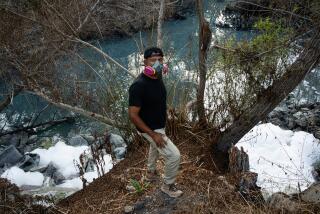Contaminants Threaten Native Land and Culture
- Share via
WYANDOTTE, Okla. — Paul Barton grew up in the ways of the Seneca-Cayuga, so he took the snake in the berry patch as a bad sign.
“Snake,” he warned, as soft and quick as the slither that parted the grass on tribal land along Grand Lake O’the Cherokees, where berries tempted passersby in fat black clumps.
Others ate the berries, which Barton’s people honor in dance. But he did not, and not because of the snake.
“Where is it safe to pick?” he asked, empty-handed in a thicket that scares him because it sits downstream from one of the most contaminated places in America. “This looks great, but the risk factor is high.”
American Indians living in and near northeast Oklahoma’s Tar Creek Superfund Site worry that traditional ways of collecting food, medicine and ceremonial items from the wild could harm them.
But stopping these cultural practices stirs a deeper fear -- the death of who they are.
“If [contamination] levels render tribal practices unsafe,” says Earl Hatley, an environmental consultant to six of the eight tribes here, “then cultural genocide will occur and tribes will die.”
In the 20 years since the federal government targeted this former lead- and zinc-mining region for priority cleanup, the tribes say their concerns have gone largely ignored.
Criticism of the government’s efforts is not new. About $100 million has been spent so far, but lead in the soil still threatens children, Tar Creek still flows orange with acid mine water, cave-ins go on and open mine shafts remain.
About 17% of the area’s population is American Indian. But the Environmental Protection Agency’s past assessments of health risks did not take into account how their lifestyles might expose them to contaminants.
Tribal people might be more inclined than the mainstream culture to use plants as medicine, the tribes say, or to cook river fish whole.
“I wouldn’t say someone is out to get the tribes, per se,” said Tabitha Worley, the Quapaw Tribe’s environmental director. “But by a lack of action, by no one taking notice, by no one working on fixing the problem, I think it leads to that.”
The EPA says it will work closely with its “tribal partners” as it enters the next cleanup phase, which will address giant mounds of mining waste and mill ponds within Ottawa County.
“We will consult with the tribes to ensure our risk assessment is responsive and protective of public health and communities throughout the area,” said Cynthia Fanning, a spokeswoman for the Dallas-based EPA office that serves Oklahoma, New Mexico, Texas, Arkansas and Louisiana.
But Hatley says that doesn’t address lands owned by tribes such as the Wyandotte, Seneca-Cayuga and Eastern Shawnee downstream.
“And they’re not going to be studying wildlife, plant life and aquatic life throughout the site, downstream and into Grand Lake,” he says.
A Seneca-Cayuga gathering spot that worries Barton lies along Grand Lake about 17 miles downstream from the Superfund site’s epicenter. He points to blackberries and sassafras, poke and wild greens, honeysuckle and buck brush as food, medicine and basket-making supplies.
“Come April,” he says, “it’s not uncommon for everyone to make a comment about [picking] wild onions.”
Barton lives his days in the “longhouse ways” of his tribe’s pre-colonial Iroquois roots, something he explains as a combination of teachings, beliefs, languages and religion.
He thanks the Creator when he awakens each day. When he picks blackberries for the berry dance, he talks to them.
“It wouldn’t be right,” he explains, “to take something without asking.”
As assistant environmental director for the Seneca-Cayuga, Barton also spends part of his time telling tribal members where not to pick, including in this field that sometimes floods with water filtered through the old mining area.
Just beyond the willows, samples taken by the U.S. Geological Survey last year found lead, cadmium and zinc in lake sediments. The zinc levels exceeded sediment standards for aquatic life.
Efforts to keep tribal members from gathering in such areas, however, are not always successful.
“People have that frame of mind, ‘It hasn’t killed me yet,’ ” Barton says.
An Oklahoma Department of Environmental Quality study recently confirmed some of the tribes’ fears. The agency warned against eating whole fish caught in rivers and ponds in the Superfund site after finding unsafe levels of lead and cadmium in some bottom feeders.
Skinless fish filets were found safe to eat, but some tribal members use a pressure cooker to can and preserve whole fish, including bones.
“It’s bad news as far as supper tonight,” said Janice Wilson, a Quapaw with a freezer full of locally caught catfish.
Hatley believes some state and federal officials have been unwilling to consider the tribes’ concerns in the past because of the implications for Grand Lake, a prime tourist and fishing destination.
The rivers that flow through the Tar Creek Superfund Site drain into the lake, but he believes commercial interests there would prefer to keep any potential environmental problems quiet.
“But it’s kind of like the canary in the cage,” Hatley says. “If it’s impacting tribes and their practices, then the dominant society is next.”
Barton, meanwhile, tries to teach his three children in traditional ways. He says he picks berries but tries to find thickets outside the Tar Creek Superfund Site’s watershed.
“You couldn’t have a berry dance without your berries,” he says.
Sure, he could buy the blackberries and strawberries needed for the dance at the grocery store.
But how would he know, he asks, if anyone had talked to them first?
More to Read
Sign up for Essential California
The most important California stories and recommendations in your inbox every morning.
You may occasionally receive promotional content from the Los Angeles Times.










